
To use PREDPP a number of PREDPP
subroutines must be linked with the NONMEM
subroutines.† This is described in detail in Guide
III. Briefly, the PREDPP subroutines consist of five
varieties:
----------
† The NONMEM load
module is also referred to as the NONMEM executable.
Typically, it is named nonmem.exe (windows) or nonmem
(Linux).
----------
|
(1) |
Routines supplied by the NONMEM Project Group (e.g. PRED), each of whose presence in a NONMEM-PREDPP load module is independent of the choice of the pharmacokinetic model. | |
|
(2) |
Routines supplied by the user (i.e. PK and ERROR), each of which must be present in a NONMEM-PREDPP load modudule. | |
|
(3) |
Routines supplied by the NONMEM Project Group (e.g. ADVAN1, TRANS1), each of whose presence in a NONMEM-PREDPP load module depends on the choice of the pharmacokinetic model and the set of basic parameters. | |
|
(4) |
Routines supplied by the user (e.g. DES), each of whose presence in a NONMEM-PREDPP load module depends on the choice of the pharmacokinetic model (these are described in Chapter VI). | |
|
(5) |
Auxilliary subroutines and files. |
With NONMEM 7, subroutine MUMODEL2 is required. This subroutine should contain only the code that is needed to compute any MU parameters (MU_1, MU_2, etc.) that are used in PK or PRED. When NM-TRAN is used, subroutine MUMODEL2 is always included in FSUBS. It is an empty subroutine unless MU parameters are defined in $PK or $PRED abbreviated code.
With NONMEM 7, subroutine FSIZESR is required. NONMEM dynamically allocates the sizes of its arrays at run-time, based on the values in FSIZESR. When NM-TRAN is used, FSIZESR is included in FSUBS.
Arrays internal to PREDPP are statically allocated to improve run times. Starting with NONMEM 7.2, module PRSIZES is required to specify the array sizes. When PREDPP is installed, module PRSIZES is found in file resource/SIZES.f90. When nmfe is used, a new version of the module is generated in file prsizes.f90. Some of the constants in PRSIZES are assessed for the current problem; others are copied from default values in SIZES.f90. If nmfe performs "pr recompilation", the appropriate routines from PREDPP are recompiled (in directory temp_dir) using constants from prsizes.f90. (Some of the constants in PRSIZES are also used to compile subroutine PRED when PREDPP is not used. Subroutine PRED may be user-supplied or generated from $PRED abbreviated code.) Note that nmfe options such as -prdefault may be used to override pr recompilation.
The user may override many of the parameter values in FSIZES and prsizes with the $SIZES record.
See Introduction to NONMEM 7, Dynamic Memory Allocation, for information about dynamic and static allocation. See Guide VIII and on-line help for information about nmfe.
Subroutines of category (1) and (3) are present in the pr directory of the installed nonmem directory, although nmfe may use recompiled versions in temp_dir as described above. Subroutines of categories (2) and (4) are not present in pr. They must be in the FSUBS file. Subroutines in FSUBS include those that are generated from NM-TRAN abbreviated code (see Guide IV), and user-written subroutines specified on the $SUBROUTINES record. The latter are copied to FSUBS for compilation.
Subroutines of category (1) are: PRED, PREDI, CHECK, SADVAN, SSS, INFN. The user can substitute a user-written routine for the INFN found on the distribution medium; see section VI.A. Another subroutine of category 1 is subroutine SSS0. Its entry name is SSS, and it may be substituted for the regular SSS routine when there are no steady-state doses in the data set (i.e. no nonzero steady-state data items appearing in dose event records). The advantage in doing this is mainly to save space in computer memory if space is a problem.
Subroutines of category (3) constitute the PREDPP Library. Their use is described in the next section.
With every NONMEM-PREDPP load module two subroutines are required, ADVAN and TRANS. Choices for each are found in the PREDPP Library. Some choices for ADVAN require additional subroutines from the Library, as well as certain user-supplied subroutines described in chapter VI.
Choices for ADVAN are named ADVAN1, ADVAN2, etc. These are informal names; the formal name for each routine is ADVAN since this is the entry name used in the calling program in PREDPP. Similarly, choices for TRANS are informally named TRANS1, TRANS2, etc.
In addition to an ADVAN and TRANS subroutine, a NONMEM-PREDPP load module may require an SS subroutine. The SS routine computes steady-state kinetics. If the computation of steady-state kinetics is specified in the data set, then an SS routine is required in the load module. Otherwise, an SS routine is still required, unless SSS0 is used (see section VII.A). For the analytic ADVANs, there is a one-to-one correspondence between ADVAN and SS subroutines. (With early versions of PREDPP, it was possible to use SS6 with analytic ADVANS. This is no longer supported.) So, for example, if the user chooses ADVAN3, then SS3 is also chosen. The SS6 subroutine computes steady-state kinetics in a very general way and may be used with the general ADVANs: ADVAN6, ADVAN8, ADVAN10, ADVAN13, ADVAN14, ADVAN16, ADVAN18. With ADVAN9 and ADVAN15 and ADVAN17, only SS9 can be used. Some SS routines also require additional subroutines from the Library, as well as certain user-supplied subroutines. NM-TRAN creates a file FREPORT that describes exactly which subroutines are needed for the NONMEM load module.
In the next subsections characterisics of each of the various ADVAN routines are tabled, including definitions of the various TRANS routines. With each ADVAN, the basic and additional PK parameters that are allowed with the ADVAN are listed. Variable names used in abbreviated code are used.
To compute the kinetic equations for a kinetic model, PREDPP - but more precisely, the chosen ADVAN - uses an internal set of parameters. For a linear kinetic model these parameters are the microconstants, i.e. rate constants, of the model. If the model is a general linear model, the MODEL subroutine specifies a numbering of these parameters (see section VI.B). The kinetic equations for a general nonlinear kinetic model PREDPP essentially consist of the differential-algebraic equations given by the user in the DES and AES routines to describe the model (see sections VI.C and VI.E). The parameters of these equations comprise the internal set of parameters.
There are only certain TRANS routines from the PREDPP Library that may be used with each choice of an ADVAN routine. (However, a user-supplied TRANS routine may be used; see section III.M.) It can be seen in the following subsections that with an ADVAN implementing a general linear or general nonlinear model, the only TRANS subroutine that may be used is TRANS1. In this case the set of basic PK parameters for TRANS1 is the same as the set of internal parameters, and TRANS1 translates each basic parameter into itself.
Compartments:

Maximum number of basic PK parameters: 2
TRANS subroutines that may be used:
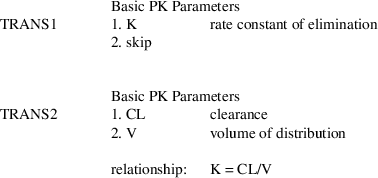
Additional PK Parameters:
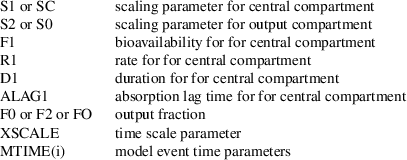
Steady-state subroutines: SS1
Other required user or Library routines: none
Compartments:

Maximum number of basic PK parameters: 3
TRANS subroutines that may be used:
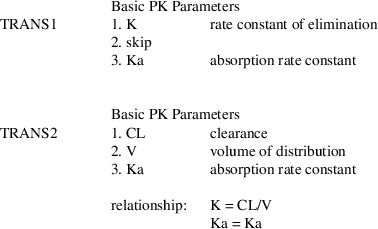
Additional PK Parameters:
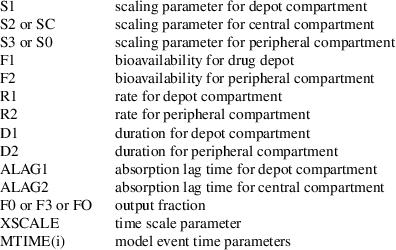
Steady-state subroutines: SS2
Other required user or Library routines: none
Compartments:

Maximum number of basic PK parameters: 4
TRANS subroutines that may be used:
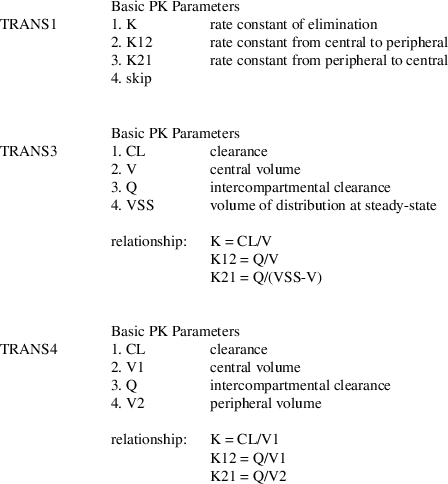
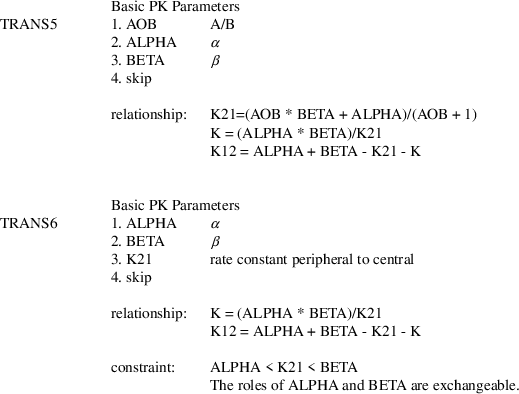
Additional PK Parameters:
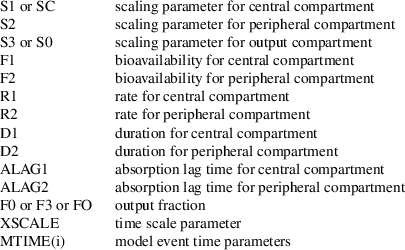
Steady-state subroutine: SS3
Other required user or Library routines: none
Compartments:

Maximum number of basic PK parameters: 5
TRANS subroutines that may be used:

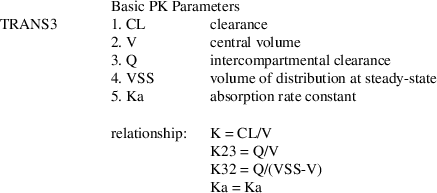
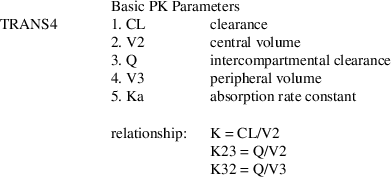
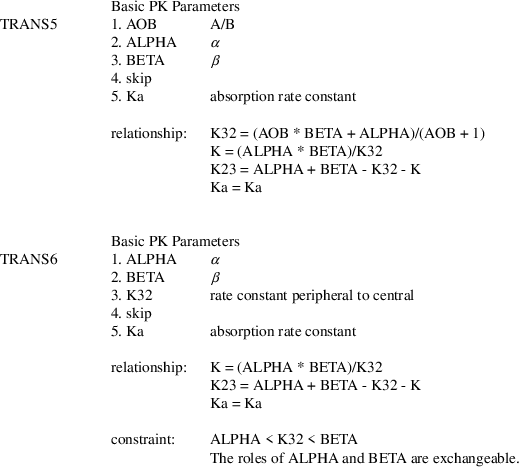
Additional PK Parameters:
S1 scaling parameter for depot compartment
S2 or SC scaling parameter for central compartment
S3 scaling parameter for peripheral compartment
S4 or S0 scaling parameter for output compartment
F1 bioavailability for depot compartment
F2 bioavailability for central compartment
F3 bioavailability for peripheral compartment
R1 rate for depot compartment
R2 rate for central compartment
R3 rate for peripheral compartment
D1 duration for depot compartment
D2 duration for central compartment
D3 duration for peripheral compartment
ALAG1 absorption lag time for depot compartment
ALAG2 absorption lag time for central compartment
ALAG3 absorption lag time for peripheral compartment
F0 or F4 or FO output fraction
XSCALE time scale parameter
MTIME(i) model event time parameters
Steady-state subroutine: SS4
Other required user or library routines: none
Compartment attributes set by subroutine MODEL. Suppose there are m compartments in the system, including the output compartment.
TRANS subroutines that may be used:
Basic PK Parameters
TRANS1 Kij or KiTj rate constant from compartment i to
compartment j
Ki0 or KiT0 rate constant from comparment i to output
compartment
Kin+1 or KiTn+1 rate constant from comparment i to output
compartment
Additional PK parameters:
For each comparment n in the system:
Sn scaling parameter for compt. n
S0 alternate name for scaling parameter for compt. m (output
compt.)
For each dosable comparment n in the system:
Fn bioavailability for compt. n
Rn rate for compt. n
Dn duration for compt. n
ALAGn absorption lag time for compt. n
Other additional PK parameters:
F0 or Fm or FO output fraction
XSCALE time scale parameter
MTIME(i) model event time parameters
Steady-state subroutine: SS5
Other required user or library
routines:
User: MODEL
Library: REXPON, RXSUBS
Notes:
|
1. |
ADVAN5 and SS5 may be used when the eigenvalues of the rate constant matrix are complex, e.g. with a physiolgical-based pharmacokinetic flow model. If the eigenvalues are known to be real (which is true for many pharmacokinetic systems), then it is more efficient to use ADVAN7 and SS7. | |
|
2. |
ADVAN5 and SS5 are based on a method involving the matrix exponential. The algorithm is described in "Contributions to the computation of the matrix exponential" by K.C. Ng. Report 212 of the Center for Pure and Applied Mathematics, University of California, Berkeley (1984). See also "A recurrence among the elements of functions of triangular matrices" by B.N. Parlett. Linear Algebra and Its Applications 14, 117-121 (1976). | |
|
3. |
The Laplacian method is not directly supported with ADVAN5. The $ESTIMATION record must include the NUMERICAL option with LAPLACIAN. | |
|
4. |
Use of the letter T as a separator between the two compartment numbers of a basic PK parameter is optional unless there are two possible interpretations of the numbers that follow K. E.g., with 12 compartments, K111 is ambiguous. It should be coded K1T11 or K11T1, depending if it symbolizes the rate constant from compartment 1 to compartment 11 or from compartment 11 to compartment 1. |
Compartment attributes set by subroutine MODEL. Suppose there are m compartments in the system, including the output compartment.
TRANS subroutines that may be used:
TRANS1 Explicit Basic PK Parameters
P(i) ith. basic PK parameter
Implicit Basic PK parameters
variable A $PK-defined variable also used in the $DES
block
Additional PK parameters:
For each comparment n in the system:
Sn scaling parameter for compt. n
S0 alternate name for scaling parameter for compt. m (output
compt.)
For each dosable comparment n in the system:
Fn bioavailability for compt. n
Rn rate for compt. n
Dn duration for compt. n
ALAGn absorption lag time for compt. n
Other additional PK parameters:
F0 or Fm or FO output fraction
XSCALE time scale parameter
MTIME(i) model event time parameters
Steady-state subroutine: SS5
Other required user or library
routines:
User: MODEL, DES, TOL
Library: DVERK1, FCN1
Notes:
|
1. |
ADVAN6 uses IMSL’s DVERK, a Runge-Kutta-Verner fifth and sixth order of method of integration, for nonstiff problems. | |
|
2. |
If SS6 is used, Library routines ZSPOW1 and FCN2 are also required. | |
|
3. |
See Chapter VI Section D.B for specification of relative and absolute tolerance. With ADVAN6, the specifications for compartment 1 apply to all compartments. | |
|
4. |
There is a limit on the number of times the differential equations are computed during any one integration over a state interval. NONMEM may terminate when this limit is reached, in which case an appropriate message appears. The limit is given by MAXFCN in SIZES. (With NONMEM 74, this is 1000000.) The $SIZES record may be used to supply a different value for MAXFCN. |
Compartment attributes set by subroutine MODEL. Suppose there are m compartments in the system, including the output compartment.
TRANS subroutines that may be used:
TRANS1 Basic PK Parameters
Kij or KiTj rate constant from compartment i to compartment
j
Ki0 or KiT0 rate constant from comparment i to output
compartment
Kin+1 or KiTn+1 rate constant from comparment i to output
compartment
Additional PK parameters:
For each comparment n in the system:
Sn scaling parameter for compt. n
S0 alternate name for scaling parameter for compt. m (output
compt.)
For each dosable comparment n in the system:
Fn bioavailability for compt. n
Rn rate for compt. n
Dn duration for compt. n
ALAGn absorption lag time for compt. n
Other additional PK parameters:
F0 or Fm or FO output fraction
XSCALE time scale parameter
MTIME(i) model event time parameters
Steady-state subroutine: SS7
Other required user or library
routines:
User: MODEL
Library: RRXPON, RXSUBS
Notes:
|
1. |
ADVAN7 and SS7 may be used when the eigenvalues of the rate constant matrix are known to be real (which is true for many pharmacokinetic systems). It is more efficient to use ADVAN7 than ADVAN5 in this case. | |
|
2. |
ADVAN7 and SS7 are based on a method involving the matrix exponential. The algorithm is a modification of that described in "Contributions to the computation of the matrix exponential" by K.C. Ng. Report 212 of the Center for Pure and Applied Mathematics, University of California, Berkeley (1984). See also "A recurrence among the elements of functions of triangular matrices" by B.N. Parlett. Linear Algebra and Its Applications 14, 117-121 (1976). | |
|
3. |
The Laplacian method is not directly supported with ADVAN7. The $ESTIMATION record must include the NUMERICAL option with LAPLACIAN. | |
|
4. |
Use of the letter T as a separator between the two compartment numbers of a basic PK parameter is optional unless there are two possible interpretations of the numbers that follow K. E.g., with 12 compartments, K111 is ambiguous. It should be coded K1T11 or K11T1, depending if it symbolizes the rate constant from compartment 1 to compartment 11 or from compartment 11 to compartment 1. |
Compartment attributes set by subroutine MODEL. Suppose there are m compartments in the system, including the output compartment.
TRANS subroutines that may be used:
TRANS1 Explicit Basic PK Parameters
P(i) ith. basic PK parameter
Implicit Basic PK parameters
variable A $PK-defined variable also used in the $DES
block
Additional PK parameters:
For each comparment n in the system:
Sn scaling parameter for compt. n
S0 alternate name for scaling parameter for compt. m (output
compt.)
For each dosable comparment n in the system:
Fn bioavailability for compt. n
Rn rate for compt. n
Dn duration for compt. n
ALAGn absorption lag time for compt. n
Other additional PK parameters:
F0 or Fm or FO output fraction
XSCALE time scale parameter
MTIME(i) model event time parameters
Steady-state subroutine: SS6
Other required user or library
routines:
User: MODEL, DES, TOL
Library: DGEAR1, FCN1, FCN3
See Note 2 regarding use of SS6
Notes:
|
1. |
ADVAN8 uses IMSL’s DGEAR, the Gear method of numerical integration, for stiff problems. | |
|
2. |
If SS6 is used, Library routines ZSPOW1 and FCN2 are also required. | |
|
3. |
See Chapter VI Section D.B for specification of relative and absolute tolerance. With ADVAN8, the specifications for compartment 1 apply to all compartments. | |
|
4. |
There is a limit on the number of times the differential equations are computed during any one integration over a state interval. NONMEM may terminate when this limit is reached, in which case an appropriate message appears. The limit is given by MAXFCN in SIZES. (With NONMEM 74, this is 1000000.) The $SIZES record may be used to supply a different value for MAXFCN. |
Compartment attributes set by subroutine MODEL. Suppose there are m compartments in the system, including the output compartment.
TRANS subroutines that may be used:
TRANS1 Explicit Basic PK Parameters
P(n) nth. basic PK parameter
Implicit Basic PK parameters
variable A $PK-defined variable also used in the $AES or
$DES block
Additional PK parameters:
For each comparment n in the system:
Sn scaling parameter for compt. n
S0 alternate name for scaling parameter for compt. m (output
compt.)
For each dosable comparment n in the system:
Fn bioavailability for compt. n
Rn rate for compt. n
Dn duration for compt. n
ALAGn absorption lag time for compt. n
Other additional PK parameters:
F0 or Fm or FO output fraction
XSCALE time scale parameter
MTIME(i) model event time parameters
Steady-state subroutine: SS9
Other required user or library
routines:
User: MODEL, DES, AES, TOL
Library: ADDA, FCN5, JAC, LEQT22, LSODI1, RES, ZSPOW2
Notes:
|
1. |
ADVAN9 uses the Livermore solver for ordinary differential equations, implicit form (LSODI), using the backward differentiation formulas (BDF) for stiff problems. ADVAN9 may be used with a system of differential-algebraic equations specifying the kinetics of a system with equilibrium compartments. It may be used with a system consisting of only algebraic equations. It may also be useful when the system consists of only stiff differential equations, and there are no equilibrium compartments. | |
|
2. |
If SS9 is used, Library routines ZSPOW1, FCN2 and FCN4 are also required. | |
|
3. |
See Chapter VI Section D.B for specification of relative and absolute tolerance. As of NM74, for ADVAN9 only, ATOL=99 specifies that variable, calculated ATOL values are to be derived, in accordance with an algorithm that is present in ADVAN9. | |
|
4. |
When there are no equilibrium compartments, the AES routine is not called, but a dummy routine may need to be included in the load module if the loader considers an unresolved reference to be a fatal error. | |
|
5. |
The Laplacian method is not directly supported with ADVAN9. The $ESTIMATION record must include the NUMERICAL option with LAPLACIAN. | |
|
6. |
There is a limit on the number of times the differential equations are computed during any one integration over a state interval. NONMEM may terminate when this limit is reached, in which case an appropriate message appears. The limit is given by MAXFCN in SIZES. (With NONMEM 74, this is 1000000.) The $SIZES record may be used to supply a different value for MAXFCN. | |
|
7. |
There is a limit on the maximum number of integration steps. For ADVAN9, it is the largest possible integer value, Reserved variable MXSTEP may be set in $PK to a smaller value. |
Compartments:
Compt. Function Initial On/Off Dose Default Default
No. Status Allowed Allowed for Dose for Obs.
1 Central On No Yes Yes Yes
2 Output Off Yes No No No
Maximum number of basic PK parameters: 3
TRANS subroutines that may be used:
Basic PK Parameters
TRANS1 1. VM maximum rate
2. KM Michaelis constant
3. skip
Additional PK Parameters:
S1 or SC scaling parameter for central compartment
S2 or S0 scaling parameter for output compartment
F1 bioavailability for central compartment
R1 rate for central compartment
D1 duration for central compartment
ALAG1 absorption lag time for central compartment
F0 or F2 or FO output fraction
XSCALE time scale parameter
MTIME(i) model event time parameters
Steady-state subroutines: SS6
Other required user or library
routines:
User: TOL
Library: MMPHI
See Note 2 regarding use of SS6
Notes:
|
1 |
The computations are based on: Beal, S.L. (1983), "Computation of the explicit solution to the Michaelis-Menten equation", Journal of Pharmacokinetics and Biopharmaceutics 11, 641-657. |
Compartments:
Compt. Function Initial On/Off Dose Default Default
No. Status Allowed Allowed for Dose for Obs.
1 Central On No Yes Yes Yes
2 Peripheral 1 On No Yes No No
3 Peripheral 2 On No Yes No No
4 Output Off Yes No No No
Maximum number of basic PK parameters: 6
TRANS subroutines that may be used:
Basic PK Parameters
TRANS1 1. K rate constant of elimination
2. K12 rate constant from central to peripheral 1
3. K21 rate constant from peripheral 1 to central
4. K13 rate constant from central to peripheral 2
5. K31 rate constant from peripheral 2 to central
6. skip
Basic PK Parameters
TRANS4 1. CL clearance
2. V1 central volume
3. Q2 intercompartmental clearance (central and periph. 1)
4. V2 peripheral 1 volume
5. Q3 intercompartmental clearance (central and periph. 2)
6. V3 peripheral 2 volume
relationship: K = CL/V1
K12=Q2/V1
K21=Q2/V2
K13=Q3/V1
K31=Q3/V3
Basic PK Parameters
TRANS6 1. ALPHA

2. BETA

3. GAMMA

4. K21 rate constant peripheral 1 to central
5. K31 rate constant peripheral 2 to central
6. skip
relationship: K = (ALPHA * BETA * GAMMA)/(K21 * K31)
K13 = (P + K31 * K31 - K31 * S - K * K21) / (K21 - K31)
K12 = S -K -K13 -K21 - K31
where:
S = ALPHA + BETA + GAMMA
P = ALPHA * BETA + ALPHA * GAMMA + BETA * GAMMA
constraint:
ALPHA<K21<BETA<K31<GAMMA
or: ALPHA<K31<BETA<K21<GAMMA
The roles of ALPHA, BETA, GAMMA, K21, K32, K12, and K13
are symmetric and are exchangeable.
Additional PK Parameters:
S1 or SC scaling parameter for central compartment
S2 scaling parameter for peripheral 1 compartment
S3 scaling parameter for peripheral 2 compartment
S4 or S0 scaling parameter for output compartment
F1 bioavailability for central compartment
F2 bioavailability for peripheral 1 compartment
F3 bioavailability for peripheral 2 compartment
R1 rate for central compartment
R2 rate for peripheral 1 compartment
R3 rate for peripheral 2 compartment
D1 duration for central compartment
D2 duration for peripheral 1 compartment
D3 duration for peripheral 2 compartment
ALAG1 absorption lag time for central compartment
ALAG2 absorption lag time for peripheral 1 compartment
ALAG3 absorption lag time for peripheral 2 compartment
F0 or F4 or FO output fraction
XSCALE time scale parameter
MTIME(i) model event time parameters
Steady-state subroutines: SS11 or SS6
Other required user or Library
routines: none
See Note 2 regarding use of SS6
|
1. |
The Laplacian method is not directly supported with ADVAN11. The $ESTIMATION record must include the NUMERICAL option with LAPLACIAN. |
Compartments:
Compt. Function Initial On/Off Dose Default Default
No. Status Allowed Allowed for Dose for Obs.
1 Depot Off Yes Yes Yes No
2 Central On No Yes No Yes
3 Peripheral 1 On No Yes No No
4 Peripheral 2 On No Yes No No
5 Output Off Yes No No No
Maximum number of basic PK parameters: 7
TRANS subroutines that may be used:
Basic PK Parameters
TRANS1 1. K rate constant of elimination
2. K23 rate constant from central to peripheral 1
3. K32 rate constant from peripheral 1 to central
4. K24 rate constant from central to peripheral 2
5. K42 rate constant from peripheral 2 to central
6. skip
7. Ka absorption rate constant
Basic PK Parameters
TRANS4 1. CL clearance
2. V2 central volume
3. Q3 intercompartmental clearance (central and periph. 1)
4. V3 peripheral 1 volume
5. Q4 intercompartmental clearance (central and periph. 2)
6. V4 peripheral 2 volume
7. Ka absorption rate constant
relationship: K = CL/V2
K23=Q3/V2
K32=Q3/V3
K24=Q4/V2
K42=Q4/V4
Ka = Ka
Basic PK Parameters
TRANS6 1. ALPHA

2. BETA

3. GAMMA

4. K32 rate constant peripheral 1 to central
5. K42 rate constant peripheral 2 to central
6. skip
7. Ka absorption rate constant
relationship: K = (ALPHA * BETA * GAMMA)/(K32 * K42)
K24 = (P + K42 * K42 - K42 * S - K * K32) / (K32 - K42)
K23 = S -K -K24 -K32 - K42
Ka = Ka
where:
S = ALPHA + BETA + GAMMA
P = ALPHA * BETA + ALPHA * GAMMA + BETA * GAMMA
constraint:
ALPHA<K32<BETA<K42<GAMMA
or: ALPHA<K42<BETA<K32<GAMMA
The roles of ALPHA, BETA, GAMMA, K32, K42, K23, and K24
are symmetric and are exchangeable.
Additional PK Parameters:
S1 scaling parameter for depot compartment
S2 or SC scaling parameter for central compartment
S3 scaling parameter for peripheral 1 compartment
S4 scaling parameter for peripheral 2 compartment
S5 or S0 scaling parameter for output compartment
F1 bioavailability depot compartment
F2 bioavailability central compartment
F3 bioavailability for peripheral 1 compartment
F4 bioavailability for peripheral 2 compartment
R1 rate depot compartment
R2 rate central compartment
R3 rate for peripheral 1 compartment
R4 rate for peripheral 2 compartment
D1 duration depot compartment
D2 duration central compartment
D3 duration for peripheral 1 compartment
D4 duration for peripheral 2 compartment
ALAG1 absorption lag time depot compartment
ALAG2 absorption lag time central compartment
ALAG3 absorption lag time for peripheral 1 compartment
ALAG4 absorption lag time for peripheral 2 compartment
F0 or F5 or FO output fraction
XSCALE time scale parameter
MTIME(i) model event time parameters
Steady-state subroutines: SS12 or SS6
Other required user or Library
routines: none
See Note 2 regarding use of SS6
|
1. |
The Laplacian method is not directly supported with ADVAN12. The $ESTIMATION record must include the NUMERICAL option with LAPLACIAN. |
Compartment attributes set by subroutine MODEL. Suppose there are m compartments in the system, including the output compartment.
TRANS subroutines that may be used:
TRANS1 Explicit Basic PK Parameters
P(n) nth. basic PK parameter
Implicit Basic PK parameters
variable A $PK-defined variable also used in the $DES
block
Additional PK parameters:
For each comparment n in the system:
Sn scaling parameter for compt. n
S0 alternate name for scaling parameter for compt. m (output
compt.)
For each dosable comparment n in the system:
Fn bioavailability for compt. n
Rn rate for compt. n
Dn duration for compt. n
ALAGn absorption lag time for compt. n
Other additional PK parameters:
F0 or Fm or FO output fraction
XSCALE time scale parameter
MTIME(i) model event time parameters
Steady-state subroutine: SS6
Other required user or library
routines:
User: MODEL, DES, TOL
Library: LSODA, FCN1, JAC2†
----------
†
With NONMEM 7.1 through NONMEM 7.3, the required subroutines
are
ZSPOW2, LEQT22, LSODA, RES, ADDA, JAC, FCN5
----------
Notes:
|
1. |
ADVAN13 uses the Livermore solver for ordinary differential equations (LSODA), with automatic method switching for stiff (BDF) and non-stiff (Adams method) problems. | |
|
2. |
If SS6 is used, Library routines ZSPOW1 and FCN2 are also required. | |
|
3. |
See Chapter VI Section D.B for specification of relative and absolute tolerance. | |
|
4. |
There is a limit on the number of times the differential equations are computed during any one integration over a state interval. NONMEM may terminate when this limit is reached, in which case an appropriate message appears. The limit is given by MAXFCN in SIZES. (With NONMEM 74, this is 1000000.) The $SIZES record may be used to supply a different value for MAXFCN. | |
|
5. |
There is a limit on the maximum number of integration steps. For ADVAN13, it is 10000. Reserved variable MXSTEP may be set in $PK to a larger value. | |
|
6. |
With NONMEM 7.4, the Laplacian Method is supported with ADVAN13. With NONMEM 7.1 through 7.3, the Laplacian method is not directly supported with ADVAN13 and the $ESTIMATION record must include the NUMERICAL option with LAPLACIAN. |
Compartment attributes set by subroutine MODEL. Suppose there are m compartments in the system, including the output compartment.
TRANS subroutines that may be used:
TRANS1 Explicit Basic PK Parameters
P(n) nth. basic PK parameter
Implicit Basic PK parameters
variable A $PK-defined variable also used in the $DES
block
Additional PK parameters:
For each comparment n in the system:
Sn scaling parameter for compt. n
S0 alternate name for scaling parameter for compt. m (output
compt.)
For each dosable comparment n in the system:
Fn bioavailability for compt. n
Rn rate for compt. n
Dn duration for compt. n
ALAGn absorption lag time for compt. n
Other additional PK parameters:
F0 or Fm or FO output fraction
XSCALE time scale parameter
MTIME(i) model event time parameters
Steady-state subroutine: SS6
Other required user or library
routines:
User: MODEL, DES, TOL
Library: CVODE, FCN1, JAC2
See Note 2 regarding use of SS6
Notes:
|
1. |
ADVAN14 uses CVODES from the LLNL SUNDIALS system for ordinary differential equations and is a descendent of LSODA (ADVAN13). The user may choose to make modifications to ..\pr\CVODEU.f90. |
See ..\guides\cvs_guide.pdf and ..\guides\cv_guide.pdf.
|
2. |
If SS6 is used, Library routines ZSPOW1 and FCN2 are also required. | |
|
3. |
See Chapter VI Section D.B for specification of relative and absolute tolerance. | |
|
4. |
There is a limit on the number of times the differential equations are computed during any one integration over a state interval. NONMEM may terminate when this limit is reached, in which case an appropriate message appears. The limit is given by MAXFCN in SIZES. (With NONMEM 74, this is 1000000.) The $SIZES record may be used to supply a different value for MAXFCN. | |
|
5. |
There is a limit on the maximum number of integration steps. For ADVAN14, it is 10000. Reserved variable MXSTEP may be set in $PK to a larger value. | |
|
6. |
ADVAN14 also has a root-finding algorithm. See the comments in CVODEU.f90 for its use. |
Compartment attributes set by subroutine MODEL. Suppose there are m compartments in the system, including the output compartment.
TRANS subroutines that may be used:
TRANS1 Explicit Basic PK Parameters
P(n) nth. basic PK parameter
Implicit Basic PK parameters
variable A $PK-defined variable also used in the $DES or
$AES block
Additional PK parameters:
For each comparment n in the system:
Sn scaling parameter for compt. n
S0 alternate name for scaling parameter for compt. m (output
compt.)
For each dosable comparment n in the system:
Fn bioavailability for compt. n
Rn rate for compt. n
Dn duration for compt. n
ALAGn absorption lag time for compt. n
Other additional PK parameters:
F0 or Fm or FO output fraction
XSCALE time scale parameter
MTIME(i) model event time parameters
Steady-state subroutine: SS9
Other required user or library
routines:
User: MODEL, AES, DES, TOL
Library: ADDA, FCN5, JAC, LEQT22, IDA, RES, ZSPOW2
Notes:
|
1. |
ADVAN15 uses IDA from the LLNL SUNDIALS system for differential-algebraic equations and is a descendent of the LSODI1 (ADVAN9) system. The user may choose to make modifications to parameters in ..\pr\IDAU.f90. |
See ..\guides\idas_guide.pdf
and ..guides\ida_guide.pdf.
See INTRODUCTION TO NONMEM 7, section "$SUBROUTINES:
Yet Another New Differential Equation Solving Method: IDAS
(ADVAN15)"
ADVAN15 may be used with a system of differential-algebraic
equations specifying the kinetics of a system with
equilibrium compartments. It may also be useful when the
system consists of only stiff differential equations, and
there are no equilibrium compartments.
|
2. |
If SS9 is used, Library routines ZSPOW1, FCN2 and FCN4 are also required. | |
|
3. |
See Chapter VI Section D.B for specification of relative and absolute tolerance. | |
|
4. |
When there are no equilibrium compartments, the AES routine is not called, but a dummy routine may need to be included in the load module if the loader considers an unresolved reference to be a fatal error. | |
|
5. |
The Laplacian method is not directly supported with ADVAN15. The $ESTIMATION record must include the NUMERICAL option with LAPLACIAN. | |
|
6. |
There is a limit on the number of times the differential equations are computed during any one integration over a state interval. NONMEM may terminate when this limit is reached, in which case an appropriate message appears. The limit is given by MAXFCN in SIZES. (With NONMEM 74, this is 1000000.) The $SIZES record may be used to supply a different value for MAXFCN. | |
|
7. |
There is a limit on the maximum number of integration steps. For ADVAN15, it is 10000. Reserved variable MXSTEP may be set in $PK to a larger value. | |
|
8. |
ADVAN15 also has a root-finding algorithm. See the comments in IDAU.f90 for its use. |
Compartment attributes set by subroutine MODEL. Suppose there are m compartments in the system, including the output compartment.
TRANS subroutines that may be used:
TRANS1 Explicit Basic PK Parameters
P(n) nth. basic PK parameter
Implicit Basic PK parameters
variable A $PK-defined variable also used in the $DES
block
Additional PK parameters:
For each comparment n in the system:
Sn scaling parameter for compt. n
S0 alternate name for scaling parameter for compt. m (output
compt.)
For each dosable comparment n in the system:
Fn bioavailability for compt. n
Rn rate for compt. n
Dn duration for compt. n
ALAGn absorption lag time for compt. n
Other additional PK parameters:
F0 or Fm or FO output fraction
XSCALE time scale parameter
MTIME(i) model event time parameters
Steady-state subroutine: SS6
Other required user or library
routines:
User: MODEL, DES, TOL
Library: RADAR5NM, FCN1, JAC2
Notes:
|
1. |
ADVAN16 uses RADAR5 Delay differential equation Solver. |
It is meant to be used with
ddexpand to add the additional ODEs inline in the NMTRAN
control stream.
See INTRODUCTION TO NONMEM 7, "Using the RADAR5 for
Delay Differential Equations with no Equilibrium
Compartments (ADVAN16) or with Equilbrium Compartments
(ADVAN17)", in "ddexpand Utility Program
(NM74)".
See ..\guides\manrad5-v2.pdf for details about the parameter
settings, and optional routines that may be incorporated.
The ..\pr\RADAR5U.f90 routine offers additional control.
|
2. |
If SS6 is used, Library routines ZSPOW1 and FCN2 are also required. | |
|
3. |
See Chapter VI Section D.B for specification of relative and absolute tolerance. | |
|
4. |
When ADVAN16 is used with delay differential equations, no additional ODEs are added to the control stream. | |
|
5. |
Some parameters of interest include those controlled by $SIZES record: |
PAST_SIZE=4000 by default,
which determines the resolution of the delay equation
storage
MAXNRDS=PC by default, but can be set to actual number of
delay compartments used to save memory.
These parameters can be set with $SIZES in the control
stream file:
$SIZES MAXNRDS=2 MXST=6000
Compartment attributes set by subroutine MODEL. Suppose there are m compartments in the system, including the output compartment.
TRANS subroutines that may be used:
TRANS1 Explicit Basic PK Parameters
P(n) nth. basic PK parameter
Implicit Basic PK parameters
variable A $PK-defined variable also used in the $AES or
$DES block
Additional PK parameters:
For each comparment n in the system:
Sn scaling parameter for compt. n
S0 alternate name for scaling parameter for compt. m (output
compt.)
For each dosable comparment n in the system:
Fn bioavailability for compt. n
Rn rate for compt. n
Dn duration for compt. n
ALAGn absorption lag time for compt. n
Other additional PK parameters:
F0 or Fm or FO output fraction
XSCALE time scale parameter
MTIME(i) model event time parameters
Steady-state subroutine: SS9
Other required user or library
routines:
User: MODEL, AES, DES, TOL
Library: ZSPOW2, LEQT22, RADAR5NM, RES, JAC, FCN5
Notes:
|
1. |
ADVAN17 may be used with a system of differential-algebraic equations specifying the kinetics of a system with equilibrium compartments. |
ADVAN17 uses RADAR5 Delay
differential equation Solver.
It is meant to be used with ddexpand to add the additional
ODEs inline in the NMTRAN control stream.
See INTRODUCTION TO NONMEM 7, "Using the RADAR5 for
Delay Differential Equations with no Equilibrium
Compartments (ADVAN16) or with Equilbrium Compartments
(ADVAN17)", in "ddexpand Utility Program
(NM74)".
See ..\guides\manrad5-v2.pdf for details about the parameter
settings, and optional routines that may be incorporated.
The ..\pr\RADAR5U.f90 routine offers additional control.
|
2. |
If SS9 is used, Library routines ZSPOW1, FCN2 and FCN4 are also required. | |
|
3. |
See Chapter VI Section D.B for specification of relative and absolute tolerance. | |
|
4. |
When there are no equilibrium compartments, the AES routine is not called, but a dummy routine may need to be included in the load module if the loader considers an unresolved reference to be a fatal error. | |
|
5. |
When ADVAN17 is used with delay differential equations, no additional ODEs are added to the control stream. | |
|
6. |
Some parameters of interest include those controlled by $SIZES record: |
MXST=4000 by default, which
determines the resolution of the delay equation storage
MAXNRDS=PC by default, but can be set to actual number of
delay compartments used to save memory.
These parameters can be set with $SIZES in the control
stream file:
$SIZES MAXNRDS=2 PAST_SIZE=4000
Compartment attributes set by subroutine MODEL. Suppose there are m compartments in the system, including the output compartment.
TRANS subroutines that may be used:
TRANS1 Explicit Basic PK Parameters
P(n) nth. basic PK parameter
Implicit Basic PK parameters
variable A $PK-defined variable also used in the $DES
block
Additional PK parameters:
For each comparment n in the system:
Sn scaling parameter for compt. n
S0 alternate name for scaling parameter for compt. m (output
compt.)
For each dosable comparment n in the system:
Fn bioavailability for compt. n
Rn rate for compt. n
Dn duration for compt. n
ALAGn absorption lag time for compt. n
Other additional PK parameters:
F0 or Fm or FO output fraction
XSCALE time scale parameter
MTIME(i) model event time parameters
Steady-state subroutine: SS6
Other required user or library
routines:
User: MODEL, DES, TOL
Library: ADDESLV, FCN1, JAC2
Notes:
|
1. |
ADVAN18 uses DDE_Solver Delay differential equation Solver. |
It is meant to be used with
ddexpand to add the additional ODEs inline in the NMTRAN
control stream.
See INTRODUCTION TO NONMEM 7, "Using the DDE_Solver for
Delay Differential Equations with no Equilibrium
Compartments (ADVAN18)", in "ddexpand Utility
Program (NM74)".
See ..\guides\ddes_f90.pdf for details about the parameter
settings, and optional routines that may be incorporated.
The ..\pr\DDESLVU.f90 routine offers additional control.
|
2 |
If SS6 is used, Library routies ZSPOW1 and FCN2 are also required. | |
|
3. |
See Chapter VI Section D.B for specification of relative and absolute tolerance. | |
|
4. |
ADVAN18/DDE_SOLVER operates with allocatable arrays, and does not require pre-sizing by the user. |